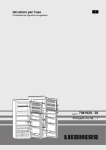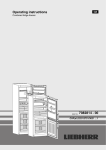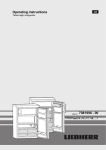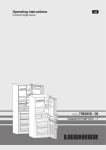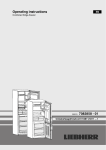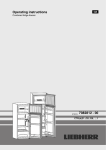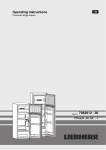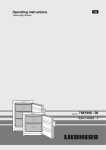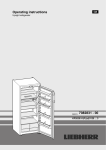Download Liebherr CTPsl 2441
Transcript
Operating instructions Combined fridge-freezer 050312 7081929 - 03 CT(P)(sl)20../24../28.. ... 1 Appliance at a glance Contents 1 1.1 1.2 1.3 1.4 1.5 Appliance at a glance............................................ Overview of the appliance and equipment................ Range of appliance use............................................ Conformity................................................................ External dimensions of the appliance....................... Saving energy.......................................................... 2 2 2 3 3 3 2 General safety information................................... 3 3 3.1 Controls and displays........................................... Operating controls.................................................... 4 4 4 4.1 4.2 4.3 4.4 4.5 4.6 4.7 Putting into operation............................................ Transporting the appliance....................................... Installing the appliance............................................. Changing the door stop............................................ Insertion into a row of kitchen units........................... Disposing of packaging............................................ Connecting the appliance......................................... Switching on the appliance....................................... 4 4 4 5 6 6 6 7 5 5.1 5.2 Control.................................................................... Refrigerator compartment........................................ Freezer compartment............................................... 7 7 7 6 6.1 6.2 6.3 6.4 Maintenance........................................................... Manual defrosting..................................................... Cleaning the appliance............................................. Changing the interior light......................................... Customer service..................................................... 8 8 8 9 9 7 Malfunction............................................................. 9 8 8.1 8.2 Decommissioning.................................................. 10 Switching off the appliance....................................... 10 Taking the appliance out of service.......................... 10 9 Disposing of the appliance................................... 10 The manufacturer works constantly on the further development of all the types and models. Therefore please understand that we have to reserve the right to make design, equipment and technical modifications. To get to know all the benefits of your new appliance, please read the information contained in these instructions carefully. The instructions apply to several models. Differences may occur. Text relating only to specific appliances is marked with an asterisk (*). Instructions for action are marked with a action are marked with a . , the results of 1 Appliance at a glance 1.1 Overview of the appliance and equipment Note u Place food inside the appliance as shown in the diagram. This allows the appliance to save energy during operation. u Shelves, drawers and baskets are arranged for optimum energy efficiency on delivery. 2 Fig. 1 (1) Freezer compartment, wire storage shelf (2) Butter shelf (3) Door rack, adjustable (4) Bottle holder (5) Shelf, adjustable (6) Shelf, separable (7) Thermostat housing, internal light (8) Drain opening (9) Bottle rack* (10) Coldest area (11) Door rack for large bottles (12) Vegetable bins (13) Type plate (14) Adjustable feet, front lifting handles, rear rollers for transport 1.2 Range of appliance use The appliance is suitable solely for cooling food in a domestic environment or similar. This includes use in, for example - in staff kitchenettes, bed and breakfast establishments, - by guests in country homes, hotels, motels and other forms of accommodation, - in catering and similar services in the wholesale trade Use the appliance solely as is customary within a domestic environment. All other types of use are inadmissible. The appliance is not suitable for storing and cooling medicines, blood plasma, laboratory preparations or similar substances and products covered by the 2007/47/EC Medical Devices Directive. Misuse of the appliance can result in the stored products suffering harm or perishing. Furthermore, the appliance is not suitable for operation in potentially explosive atmospheres. The appliance is set to operate within specific ambient temperature limits according to its climate rating. The correct climate rating for your appliance is indicated on the type plate. Note u Compliance with the ambient temperatures indicated is required, otherwise the cooling performance is reduced. Climate rating for ambient temperatures of SN 10 °C to 32 °C N 16 °C to 32 °C ST 16 °C to 38 °C T 16 °C to 43 °C General safety information 1.3 Conformity 2 General safety information The refrigerant circuit is tested for leakage. The appliance complies with the relevant safety regulations and EC Directives 2006/95/EC, 2004/108/EC, 2009/125/EC and 2010/30/EU. Danger for the user: - This appliance is not designed for persons (including children) with physical, sensory or mental impairment or persons not having sufficient experience and knowledge, unless they are instructed in the use of the appliance and are initially supervised by a person responsible for their safety. Keep children under supervision to ensure they do not play with the appliance. - In case of a fault, pull out the mains plug (not by pulling the connecting cable) or switch off the fuse. - Have any repairs to or intervention in the appliance, and any change of the mains power cable, carried out by the customer service only or by other specialised personnel trained for the purpose. - When disconnecting the appliance from the supply, always take hold of the plug. Do not pull the cable. - Install and connect the appliance only as instructed. - Please keep these instructions in a safe place and pass them on to any subsequent owners. - Special-purpose lamps (incandescent lamps, LEDs, fluorescent tubes) in the appliance serve to illuminate the appliance interior and are not suited for room illumination.* Fire hazard: - The refrigerant R 600a is environmentally friendly but flammable. Escaping refrigerant may ignite. • Do not damage the refrigerant circuit pipes. • Do not allow naked flames or ignition sources to enter the appliance. • Do not use any electrical appliances in the interior (e.g. steam cleaners, heaters, ice cream maker etc.). • If refrigerant escapes: eliminate naked flames or sources of ignition from the vicinity. Pull out the power plug. Ventilate the area well. Notify customer service. - Do not store explosives or sprays using combustible propellants such as butane, propane, pentane, etc. in the appliance. To identify these spray cans, look for the list of contents printed on the can, or a flame symbol. Gases possibly escaping may ignite due to electrical components. - Keep burning candles, lamps and other items with naked flames away from the appliance so that they do not set the appliance on fire. - Always store high-percentage alcohol in tightly sealed, upright containers. Alcohol possibly escaping may ignite due to electrical components. Danger of tipping and falling: - Do not misuse the plinth, drawers, doors etc. as a step or for support. This applies particularly to children. Danger of food poisoning: - Do not consume food which has been stored too long. 1.4 External dimensions of the appliance Fig. 2 Model A C D E G H CT2011 550 560 1127 629 615 1230 CT(sl)2051 550 560 1127 629 615 1230 CT2411 550 560 1127 629 615 1425 CT(P)(sl)2441 550 560 1127 629 615 1425 CT(sl)2841 550 560 1127 629 615 1570 1.5 Saving energy - Always ensure good ventilation. Do not cover ventilation openings or grille. - Do not place appliance in areas of direct sunlight or next to a stove, heater or similar object. - The energy consumption depends on the installation conditions, e.g. the ambient temperature (see 1.2) . - Keep the time the appliance is open to a minimum. - The lower the temperature setting, the higher the power consumption. - Store food logically. (see Appliance at a glance). - Ensure that all food is well packed and covered for storage. This will prevent frost from forming. - Remove food as needed in order that it does not warm too much. - First cool warm food to room temperature before storing it . - Defrost frozen food in the refrigerator. - If there is a thick layer of frost in the appliance: defrost the appliance. Accumulated dust increases the energy consumption: - Once a year, dust the refrigerating unit together with the metal grille of the heat exchanger at the back of the appliance. Danger of frostbite, numbness and pain: - Avoid lasting skin contact with cold surfaces or refrigerated/ frozen food or take protective steps, e.g. wear gloves. Do not consume ice cream, water ice or ice cubes immediately and do not consume them too cold. Please observe the specific information in the other sections: DANGER identifies a situation involving direct danger which, if not obviated, may result in death or severe bodily injury. WARNING identifies a dangerous situation which, if not obviated, may result in death or severe bodily injury. 3 Controls and displays CAUTION identifies a dangerous situation which, if not obviated, may result in minor or medium bodily injury. NOTICE identifies a dangerous situation which, if not obviated, may result in damage to property. Note identifies useful information and tips. 3 Controls and displays WARNING Fire hazard due to refrigerant! The refrigerant R 600a is environmentally friendly but flammable. Escaping refrigerant may ignite. u Do not damage the piping of the refrigeration circuit. WARNING Fire hazard and danger of damage! u Do not place appliances emitting heat e.g. microwaves, toasters etc. on the appliance! 3.1 Operating controls WARNING Blocked ventilation openings pose a risk of fire and damage! u Always keep the ventilation openings clear. Always ensure that the appliance is properly ventilated! (1) Temperature controller (2) Cool-Plus switch Fig. 3 4 Putting into operation 4.1 Transporting the appliance CAUTION Risk of injury and danger of damage as a result of incorrect transport! u Transport the appliance in a packed condition. u Transport the appliance upright. u Do not transport the appliance without assistance. 4.2 Installing the appliance WARNING Fire hazard due to dampness! If live parts or the mains lead become damp this may cause short circuits. u The appliance is designed for use in enclosed areas. Do not operate the appliance outdoors or in areas where it is exposed to splash water or damp conditions. WARNING Risk of fire due to short circuit! If the mains cable/connector of the appliance or of another appliance touch the rear of the appliance, the mains cable/ connector may be damaged by the appliance vibrations, leading to a short circuit. u Stand the appliance so that it is not touched by connectors or main cables. u Do not plug the appliance or any others into sockets located near the rear of the appliance. 4 NOTICE Risk of damage due to condensate! u Do not install the appliance directly alongside a further refrigerator/freezer. q In the event that the appliance is damaged, contact the supplier immediately before connecting to the mains. q The floor at the site must be flat and level. q Do not install the appliance in a location where it is exposed to direct radiation of the sun, next to a cooker, heater and similar. q Always stand the appliance backed directly to the wall using the enclosed wall spacers (see below). q The appliance may be moved only when it is empty. q Do not install the appliance without assistance. q Standard EN 378 specifies that the room in which you install your appliance must have a volume of 1 m2 per 8 g of R 600a refrigerant used in the appliance. If the room in which the appliance is installed is too small, a flammable gas-air mixture may form in the event of a leakage in the refrigeration circuit. The quantity of refrigerant used in your appliance is indicated on the type plate on the inside of the appliance. u Detach the connecting cable from the rear of the appliance, removing the cable holder at the same time because otherwise there will be vibratory noise! NOTICE The stainless steel doors are finished with a high quality surface coating and must not be treated with the enclosed care product, as otherwise the surface coating will be damaged. u Please only use a soft clean cloth to wipe the coated door surfaces. u Only use a stainless steel care product on the stainless steel side walls, applying it evenly in the direction of polishing. Subsequent cleaning will then be easier. u Use only a soft clean cloth to wipe side walls and door surfaces with a paint finish. u Remove the protective film from the decorative trims. u Remove all transit supports. u Dispose of packaging material (see 4.5) . Putting into operation 4.3 Changing the door stop* u Align the appliance so that it stands firmly and on a level by applying the accompanying spanner to the adjustableheight feet (A) and using a spirit level. u Then support the door: Extend the adjustable foot at the turn hinge (B) until it rests on the floor and then make a further 90° turn. You can change over the door hinges if necessary. Make sure that the following tools are to hand: q Torx® 25 q Torx® 20 q Screwdriver q Supplied open-ended wrench q If necessary, a second person to assist with installation Note u Clean the appliance (see 6.2) . If the appliance is installed in a very damp environment, condensate may form on the outside of the appliance. u Always see to good ventilation at the installation site. u Follow the order of the items in the diagram. CAUTION Risk of injury if the door tips! u Take good hold of the door. u Set down the door carefully. Fig. 4 5 Putting into operation Fig. 5 u Follow the order of the positions. 4.4 Insertion into a row of kitchen units If the appliance is installed with the hinges next to a wall Fig. 6 (4), the distance between appliance and wall has to be at least 40 mm. This corresponds to the projection of the handle when the door is open. 4.5 Disposing of packaging WARNING Danger of suffocation due to packing material and plastic film! u Do not allow children to play with packing material. The packaging is made of recyclable materials: - corrugated board/cardboard - expanded polystyrene parts - polythene bags and sheets - polypropylene straps - nailed wooden frame with polyethylene panel* u Take the packaging material to an official collecting point. 4.6 Connecting the appliance Fig. 6 (1) Stack cabinet (3) Kitchen cabinet (2) Appliance (4) Wall The appliance can be inserted into a row of kitchen units. To match the appliance Fig. 6 (2) to the height of the row of units, a suitable stack cabinet Fig. 6 (1) can be fitted above the appliance. When inserting the appliance into a row of kitchen units (max. depth 580 mm), the appliance can be installed directly next to the kitchen unit Fig. 6 (3). The appliance door projects relative to the front of the kitchen unit by 34 mm at the side and by 50 mm in the middle of the appliance. It can be opened and closed perfectly as a result. - the larger the ventilation space, the more energy-saving the appliance is in operation. 6 NOTICE Risk of damage to the electronic control system! u Do not use stand-alone inverters (conversion of d.c. to a.c./ three-phase) or energy saving plugs. WARNING Fire and overheating hazard! u Do not use extension cables or multiple socket outlets. The type of current (alternating current) and voltage at the installation site have to conform with the data on the type plate (see Appliance at a glance). Control Connect the appliance only with a properly installed socket outlet with earthing contact. The socket outlet must be fused with 10 A or higher. It must be easily accessible so that the appliance can be quickly disconnected from the supply in an emergency. It must be outside the area of the rear of the appliance. u Check the electrical connection. u Plug in the power plug. 4.7 Switching on the appliance Put the appliance into operation about 2 hours before first loading food to be frozen. u Turn the temperature control Fig. 3 (1) to the right, from the 0 setting to point 3. w The interior light is on. Note u At normal room temperatures, in excess of 18 °C, the CoolPlus switch should be turned off, as it is not required. The temperature depends on the following factors: - the door opening frequency - the room temperature at the site where the appliance is installed - the type, temperature and quantity of frozen food u Adjust the temperature as needed, using the control. 5.1.3 Relocating the shelves The shelves have stops preventing them from being unintentionally pulled out. u Lift the shelf and draw it out forwards. u Insert shelf with the raised edge pointing upwards at the back. 5 Control 5.1 Refrigerator compartment The natural circulation of air in the refrigerator compartment results in zones differing in temperature. It is coldest directly above the vegetable drawers and at the rear wall. It is warmest at the top front of the compartment and in the door. 5.1.1 Food refrigeration u Store perishable food such as ready-to-serve dishes, meat products and sausages in the coldest zone. Place butter and preserves in the upper area and in the door (see Appliance at a glance). u Use recyclable plastic, metal, aluminium and glass containers and cling film for wrapping. u Always store liquids and food which is subject to odour or taste transfer in closed containers or cover them. u Foods which give off a large amount of ethylene gas and delicate foods, such as fruit, vegetables, salad, should always be stored separately or wrapped so as not to reduce the storage life; e.g. do not store tomatoes together with kiwis or cabbage. u Do not store food too close together to enable good air circulation. u To safeguard bottles from tipping over: move the bottle holder. 5.1.2 Setting the temperature The temperature can be set between 1 (warmest temperature, minimum cooling performance) and 7 (coldest temperature, maximum cooling performance). The middle control setting is recommended, then a middle temperature of approx.5 °C is established in the refrigerator compartment. To ensure ideal temperatures for storing frozen foods, a setting of "4" to "7" on the temperature controller is recommended. Selecting "7" makes it possible to achieve temperatures under 0 °C in the coldest part of the fridge compartment. An average temperature of approx. –18 °C is then established in the freezer compartment u Turn the temperature control Fig. 3 (1). At low room temperatures of 18 °C or lower: u Press the Cool-Plus switch Fig. 3 (2). w The deep temperatures in the freezer compartment are ensured. w The appliance's interior lighting is lit on a dim setting even when the door is closed. 5.1.4 Using the sectioned shelf CAUTION Danger of laceration! The shelf may break. The broken fragments may cause laceration. u Remove only empty shelves. Fig. 7 u The glass shelf with stop face (2) has to be at the back. 5.1.5 Removing the storage rack u Remove storage rack according to illustration. 5.1.6 Removing the bottle holder u Remove the bottle holder according to the illustration. 5.2 Freezer compartment You can store frozen food, make ice cubes and freeze fresh food in the freezer compartment. 7 Maintenance 5.2.1 Freezing food The rating plate indicates the maximum quantity of fresh food you can freeze within 24 hours (see Appliance at a glance) under "Freezing capacity ... kg/24h". CAUTION Risk of injury due to broken glass! Bottles and cans containing drinks may burst when being frozen. This applies particularly to sparkling drinks. u Do not freeze bottles and cans containing drinks! u 24 h before freezing food, set the temperature to a medium to cold position. u To switch on Cool-Plus: press Cool-Plus button. Fig. 3 (2) In order that the food is rapidly frozen through to the core, do not exceed the following quantities per pack: - Fruit, vegetables up to 1 kg - Meat up to 2.5 kg u Pack the food in portions in freezer bags, reusable plastic, metal or aluminium containers. u Spread the food over the shelf. Do not allow it to contact and thaw items that are already frozen. u Set the temperature back again 24 h after placing the food inside. If the room temperature is higher than 18 °C: u switch off Cool-Plus: press Cool-Plus button Fig. 3 (2) . 5.2.2 Storage life Standard values for the storage life of various types of food in the freezer compartment: Ice-cream 2 to 6 months Sausage, ham 2 to 6 months Bread, bakery products 2 to 6 months Game, pork 6 to 10 months Fatty fish 2 to 6 months Lean fish 6 to 12 months Cheese 2 to 6 months Poultry, beef 6 to 12 months Vegetables, fruit 6 to 12 months The values indicated for storage life are standard ones. 5.2.3 Thawing food u in the refrigerator compartment at room temperature in a microwave oven in a conventional or fan oven Remove only as much food as is required. Use thawed food as quickly as possible. u Food once thawed should be re-frozen only in exceptional cases. 6 Maintenance 6.1 Manual defrosting The refrigerator compartment is defrosted automatically. The defrost water evaporates as a result of the heat of the compressor. Drops of water on the rear wall are perfectly normal. u Regularly clean the drain opening to allow the water to flow away (see 6.2) . 8 A layer of frost or ice can build up in the freezer compartment after a long period of operation. The layer of frost or ice builds up faster if the appliance is opened often or if the food is warm when placed inside. However, a thick layer of ice will increase the appliance‘s energy consumption. You should therefore defrost the appliance regularly. CAUTION Risk of injury and damage as a result of hot steam! u Do not use electric heaters or steam cleaners, naked flames or defrosting sprays for defrosting. u Do not remove ice using sharp instruments. u Switch off the appliance. u Pull out the power plug or switch off the fuse. u If possible, put the frozen goods in the freezer drawer, wrapped in newspaper or a blanket, and store in a cool place. u Place a pan with hot, not boiling water on a middle shelf. Defrosting is speeded up. Leave the door of the appliance open while defrosting. Remove detached pieces of ice. If necessary, pick up defrost water several times, using a sponge or cloth. u Clean the appliance (see 6.2) . w u u u 6.2 Cleaning the appliance CAUTION Risk of injury and damage as a result of hot steam! Hot steam may damage the surfaces and cause burns. u Do not use any steam cleaners! NOTICE Incorrect cleaning damages the appliance! u Do not use cleaning agents in concentrated form. u Do not use any scouring or abrasive sponges or steel wool. u Please do not use any aggressive, scouring, sand-, chloride-, chemical- or acid-based cleaning agents. u Do not use chemical solvents. u Do not damage or remove the type plate on the inside of the appliance. It is important for the customer service. u Do not pull off, bend or damage cables or other components. u Do not allow any cleaning water to enter the drain channel, ventilation grille or electrical parts. u Please use soft cleaning cloths and a universal pH-neutral cleaning agent. u Please use cleaning and care products suitable for contact with foodstuffs in the appliance interior. u Empty appliance. u Pull out the power plug. u Clean the vent grille regularly. w Dust deposits increase energy consumption. u Clean plastic outer and inner surfaces with lukewarm water and a little washing-up liquid. Malfunction NOTICE The stainless steel doors are finished with a high quality surface coating and must not be treated with the enclosed care product, as otherwise the surface coating will be damaged. u Please only use a soft clean cloth to wipe the coated door surfaces. In the case of heavy soiling, use a little water or neutral cleaning agent. A micro-fibre cloth can be used optionally. u When soiled, clean stainless steel side walls with a commercially available stainless steel cleaning agent. Then apply the enclosed stainless steel care product evenly in the direction of polishing. u Use only a soft clean cloth to wipe side walls and door surfaces with a paint finish. In the case of heavy soiling, use a little water or neutral cleaning agent. A micro-fibre cloth can be used optionally. u Clean drain hole: Remove deposits with a narrow instrument, e.g. a cotton bud. u Clean items of equipment by hand with lukewarm water and a little washing-up liquid. u Remove the support rails for the half glass shelves for cleaning. u Dismantle door racks as illustrated. After cleaning: u Wipe dry the appliance and items of equipment. u Connect the appliance and switch it on again. When the temperature is sufficiently cold: u Put the food back inside. 6.3 Changing the interior light u u u u u u max. 15 W Socket: E14 Type of current and voltage must conform with the details on the type plate Switch off the appliance. Pull out the power plug or switch off the fuse. Take hold of the lamp cover. As shown in the diagram, press open the lamp cover on the inside at the front, and pull it off to the side. Change the bulb. Put on the lamp cover again and snap it into place. WARNING Risk of injury if repair work is not carried out professionally! u Have any repairs and action - not expressly specified - on the appliance and mains cable carried out by service personnel only. (see Maintenance) u Read the appliance designation Fig. 8 (1), service No. Fig. 8 (2) and serial No. Fig. 8 (3) off the type plate located inside the appliance on the lefthand side. Fig. 8 u Notify the customer service, specifying the fault, appliance designation Fig. 8 (1), service No. Fig. 8 (2) and serial No. Fig. 8 (3). w This will help us to provide you with a faster and more accurate service. u Keep the appliance closed until the customer service arrives. w The food will stay cool longer. u Pull out the mains plug (not by pulling the connecting cable) or switch off the fuse. 7 Malfunction Your appliance is designed and manufactured for a long life span and reliable operation. If a malfunction nonetheless occurs during operation, check whether it is due to a handling error. In this case you will have to be charged for the costs incurred, even during the warranty period. You may be able to rectify the following faults yourself: Appliance does not work. → The appliance is not switched on. u Switch on the appliance. → The power plug is not properly inserted in the wall socket. u Check power plug. → The fuse of the wall socket is not in order. u Check fuse. The compressor runs for a long time. → The compressor switches to a low speed when little cold is needed. Although the running time is increased as a result, energy is saved. u This is normal in energy-saving models. A LED on the bottom rear of the appliance (at the compressor) flashes regularly every 15 seconds*. → The inverter is equipped with a diagnostic LED. u The flashing is normal. Excessive noise. → Speed-controlled* compressors may produce varying running noise due to different speed steps. u The sound is normal. A bubbling and gurgling noise. → This noise comes from the refrigerant flowing in the refriger- 6.4 Customer service First check whether you can correct the fault yourself by reference to the list (see Malfunction). If this is not the case, please contact the customer service whose address is given in the enclosed customer service list. ation circuit. u The sound is normal. A quiet clicking noise. → The noise is produced whenever the refrigeration unit (motor) automatically switches on or off. u The sound is normal. 9 Decommissioning A hum. It is briefly a little louder when the refrigeration unit (the motor) switches on. → The refrigeration increases automatically when fresh food has just been placed in the appliance or the door has been left open for a while. u The sound is normal. → The ambient temperature is too high. u Solution: (see 1.2) Vibratory noise. → The appliance is not standing firmly on the floor. As a result, adjoining units or objects are set into vibration by the running refrigeration unit. u Move the appliance away a little and align it using the adjustable feet. u Move bottles and containers apart. The temperature is not cold enough. → The door of the appliance is not properly closed. u Close the door of the appliance. → Insufficient ventilation. u Clear ventilation grilles. → The ambient temperature is too high. u Solution: (see 1.2) . → The appliance was opened too frequently or for too long. u Wait until the appliance reaches the required temperature itself. If not, contact the customer service. (see Maintenance). → The appliance is too close to a heat source. u Solution: (see Putting into operation). The interior light is not on. → The appliance is not switched on. u Switch on the appliance. → The bulb is faulty. u Replace the bulb. (see Maintenance). u To ensure that the Cool-Plus function remains fully operational, the defective bulb should be replaced as soon as possible. 8 Decommissioning 8.1 Switching off the appliance u Turn temperature control Fig. 3 (1) to 0. 8.2 Taking the appliance out of service u Empty the appliance. u Pull out the power plug. u Clean the appliance (see 6.2) . u Leave the door open to prevent odour. 9 Disposing of the appliance The appliance contains some reusable materials and should be disposed of properly - not simply with unsorted household refuse. Appliances which are no longer needed must be disposed of in a professional and appropriate way, in accordance with the current local regulations and laws. When disposing of the appliance, ensure that the refrigeration circuit is not damaged to prevent uncontrolled escape of the refrigerant it contains (data on type plate) and oil. u Disable the appliance. u Pull out the plug. u Cut through the connecting cable. 10










